For the 2025 school year, there is 1 public elementary school serving 143 students in East Millinocket School District. This district's average elementary testing ranking is 4/10, which is in the bottom 50% of public elementary schools in Maine.
Public Elementary School in East Millinocket School District have an average math proficiency score of 85% (versus the Maine public elementary school average of 81%), and reading proficiency score of 75% (versus the 84% statewide average).
Minority enrollment is 7% of the student body (majority Hispanic), which is less than the Maine public elementary school average of 14% (majority Black and Hispanic).
Overview
This School District
This State (ME)
# Schools
2 Schools
442 Schools
# Students
245 Students
112,991 Students
# Teachers
25 Teachers
10,443 Teachers
Student : Teacher Ratio
10:1
10:1
District Rank
East Millinocket School District, which is ranked within the bottom 50% of all 191 school districts in Maine (based off of combined math and reading proficiency testing data) for the 2021-2022 school year.
The school district's graduation rate of 70% has decreased from 90% over five school years.
Overall District Rank
#188 out of 222 school districts
(Bottom 50%)
(Bottom 50%)

Math Test Scores (% Proficient)
70-74%
82%
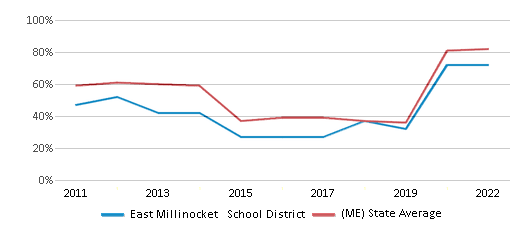
Reading/Language Arts Test Scores (% Proficient)
70-74%
84%
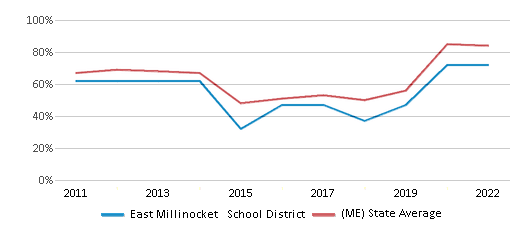
Science Test Scores (% Proficient)
11-19%
37%
Graduation Rate
70%
86%
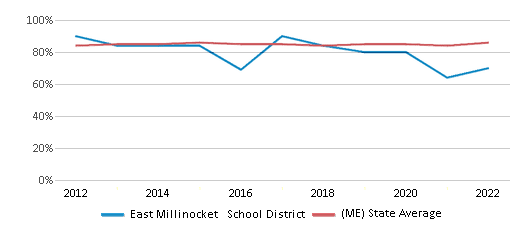
Students by Ethnicity:
Diversity Score
0.13
0.26
# American Indian Students
n/a
878 Students
% American Indian Students
n/a
1%
# Asian Students
n/a
1,363 Students
% Asian Students
n/a
1%
# Hispanic Students
7 Students
3,921 Students
% Hispanic Students
3%
3%
# Black Students
n/a
5,274 Students
% Black Students
n/a
5%
# White Students
229 Students
97,025 Students
% White Students
93%
86%
# Hawaiian Students
n/a
101 Students
% Hawaiian Students
n/a
n/a
# Two or more races Students
9 Students
4,429 Students
% of Two or more races Students
4%
4%
Students by Grade:
# Students in PK Grade:
15
5,730
# Students in K Grade:
27
11,081
# Students in 1st Grade:
27
11,901
# Students in 2nd Grade:
25
12,646
# Students in 3rd Grade:
25
11,955
# Students in 4th Grade:
24
12,471
# Students in 5th Grade:
-
12,477
# Students in 6th Grade:
-
12,250
# Students in 7th Grade:
-
10,478
# Students in 8th Grade:
-
10,197
# Students in 9th Grade:
23
451
# Students in 10th Grade:
24
468
# Students in 11th Grade:
32
470
# Students in 12th Grade:
23
416
# Ungraded Students:
-
-
District Revenue and Spending
The revenue/student of $21,392 in this school district is less than the state median of $21,600. The school district revenue/student has stayed relatively flat over four school years.
The school district's spending/student of $20,714 is less than the state median of $21,191. The school district spending/student has stayed relatively flat over four school years.
Total Revenue
$5 MM
$3,617 MM
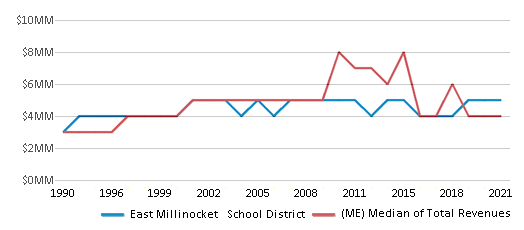
Spending
$5 MM
$3,549 MM
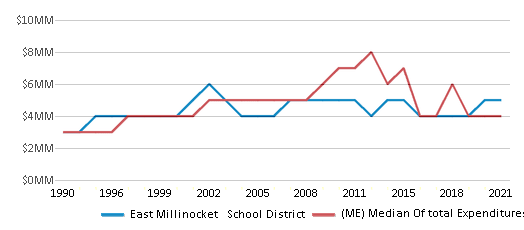
Revenue / Student
$21,392
$21,600
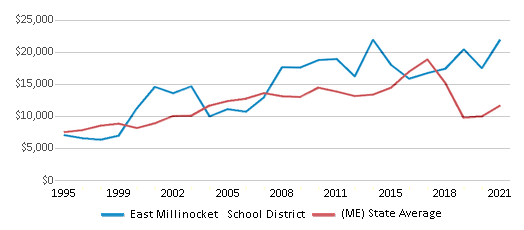
Spending / Student
$20,714
$21,191

Best East Millinocket School District Public Elementary Schools (2025)
School
(Math and Reading Proficiency)
(Math and Reading Proficiency)
Location
Grades
Students
Rank: #11.
Opal Myrick Elementary School
(Math: 80-89% | Reading: 70-79%)
Rank:
Rank:
4/
Bottom 50%10
45 North Street
East Millinocket, ME 04430
(207) 746-3511
East Millinocket, ME 04430
(207) 746-3511
Grades: PK-4
| 143 students
Recent Articles

Year-Round Or Traditional Schedule?
Which is more appropriate for your child? A year-round attendance schedule or traditional schedule? We look at the pros and cons.

Why You Should Encourage Your Child to Join a Sports Team
Participating in team sports has a great many benefits for children, there is no doubt. In this article you will learn what those benefits are.

White Students are Now the Minority in U.S. Public Schools
Increasing birth rates among immigrant families from Asia and Central and South America, combined with lower birth rates among white families, means that for the first time in history, public school students in the United States are majority-minority. This shift in demographics poses difficulties for schools as they work to accommodate children of varying language abilities and socio-economic backgrounds.





